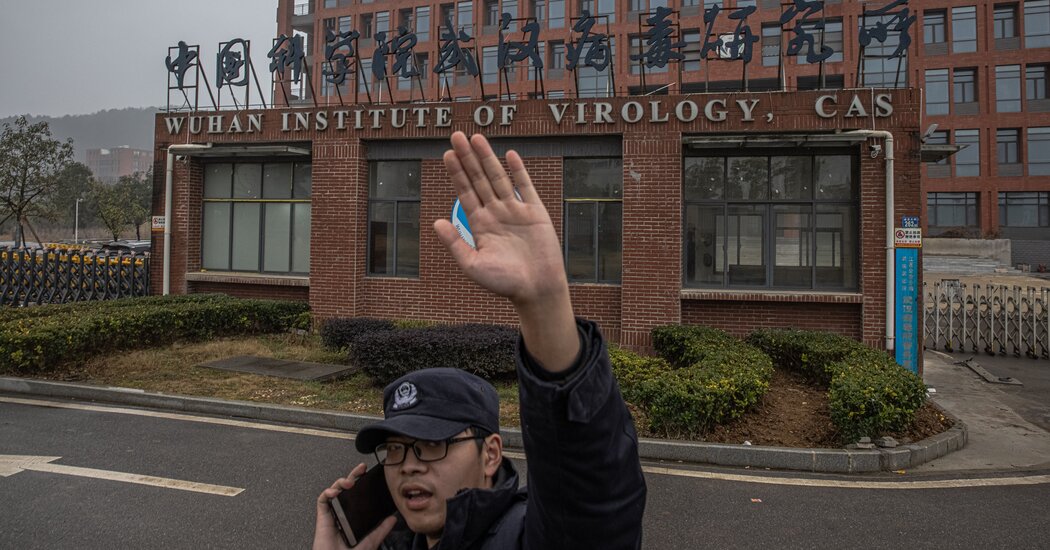
WASHINGTON — American intelligence agencies are unlikely to be able to draw a firm conclusion about the origin of the novel coronavirus without more information from China on the earliest cases or new scientific discoveries about the nature of the virus, said a newly declassified intelligence report released on Friday.
President Biden ordered the nation’s intelligence agencies in May to conduct a 90-day inquiry into the origins of the pandemic. When the key findings of that review were released in August, they failed to offer a single answer and instead reaffirmed the longstanding position of the agencies: The theory that the virus occurred naturally and the theory that it was accidentally created in a lab were both plausible.
But the report on Friday reiterated that the evidence to support either conclusion was thin, and that U.S. intelligence agencies know far too little about the origin of the virus. The intelligence community has concluded that the virus was not developed as a biological weapon.
Analysts “assess that a natural origin and a laboratory associated incident are both plausible hypotheses for how SARS-CoV-2 first infected humans,” the report said. “Analysts, however, disagree on which is more likely, or whether an assessment can be made at all.”
Four intelligence agencies, and the National Intelligence Council, consider the natural causes theory more plausible. One agency, the Federal Bureau of Investigation, backs the lab leak theory. But none of those agencies have delivered to the director of national intelligence or the White House a high-confidence assessment, which shows the doubt that continues to swirl around the question.
The intelligence community has broadly concluded that the virus causing Covid-19 was not deliberately engineered in a lab. But even that conclusion is made only with low confidence. Some genetic engineering techniques make modifications difficult to identify, particularly given existing gaps in knowledge about the diversity of naturally occurring coronaviruses.
“Some genetic engineering techniques may make genetically modified viruses indistinguishable from natural viruses, according to academic journal articles,” the report said.
The intelligence report said the Wuhan Institute of Virology had previously made chimeras, or combinations of coronavirus that did not occur in nature. But that record provides little insight on whether the virus that causes Covid was genetically engineered, the report said.
Some Republican lawmakers have seized on that so-called gain-of-function work at the institute, arguing it buttresses the lab leak theory. At a House Intelligence Committee hearing this week, Representative Brad Wenstrup, Republican of Ohio and a medical doctor, called for more examination of the institute’s work on creating chimeras.
“In this case, that means experimentally combining components from two viruses into one for the sake of making it more infectious to the general public,” said Mr. Wenstrup, who has called for more hearings on the origin of the pandemic. “I can’t be sure that Covid-19 originated from a research-related accident or infection from a sampling trip, but I’m 100 percent sure there was a massive cover-up.”
The National Institutes of Health has said the chimera experiments in Wuhan were based on coronaviruses that were not the progenitors of the virus that causes Covid.
There is broad agreement in the Biden administration that China has not shared all it can about the origins of the outbreak. The intelligence report released on Friday called for more transparency by China, and said Beijing needed to release information about possible intermediate species that the virus could have infected before leaping to humans, what it knows about the nature of the first human infections and more data about the Wuhan Institute of Virology’s research work.
But the report also made clear that on some matters Chinese officials were initially caught off guard. Critically, American intelligence analysts have assessed that Chinese officials did not know about the existence of the novel coronavirus until after Covid was detected in the population and it was isolated by the Wuhan institute.
“Accordingly, if the pandemic originated from a laboratory-associated incident, they probably were unaware in the initial months that such an incident had occurred,” the report said.
The report also suggested that the Wuhan institute researchers were not aware of the virus until the outbreak was underway, since they quickly pivoted to working on Covid as the outbreak grew worse. The new report relied heavily on the apparent surprise of Chinese officials and the Wuhan institute’s researchers as the pandemic grew worse to buttress the natural causes theory.
The wide array of animals susceptible to the virus causing Covid, and the various ways humans in China come in contact with those animals — including trafficking, farming, sale and rescue — make natural transmission possible.
While no animal source has been found, “analysts that assess the pandemic was due to natural causes note that in many previous zoonotic outbreaks, the identification of animal sources has taken years, and in some cases, animal sources have not been identified,” the report said.
On the flip side, analysts who supported the lab leak theory have also not found a smoking gun. Instead, they have highlighted that previous coronavirus work at the Wuhan institute was conducted under “inadequate biosafety conditions that could have led to opportunities for a laboratory-associated incident.”
The report said that some of the closest known relatives to the virus that causes Covid were found in bats from Yunnan Province. Researchers bringing samples to Wuhan could “provide a plausible link between these habitats and the city.”
“These analysts note that it is plausible that researchers may have unwittingly exposed themselves to the virus without sequencing it during experiments or sampling activities, possibly resulting in asymptomatic or mild infection,” the report said.
However, scientists have estimated that viruses identified in Yunnan diverged 40 years ago from the ancestors of SARS-CoV-2. Other viruses found in Laos bear a much closer similarity in some of their genes, and scientists expect that further investigation will uncover even more closely related coronaviruses in bats.
Carl Zimmer contributed reporting.



